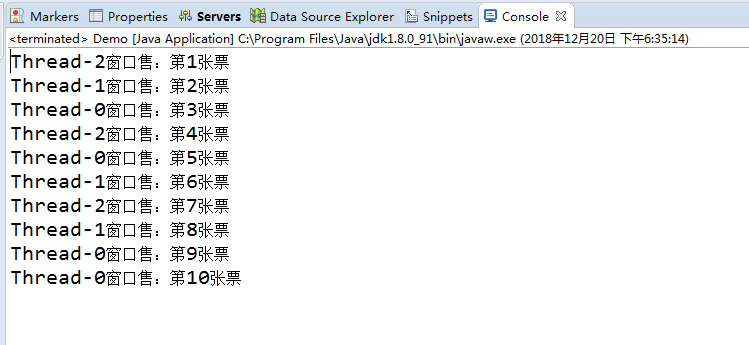201771010123汪慧和《面向物件程式設計Java》第十七週實驗總結
一、理論部分
1、多執行緒併發執行中的問題
◆多個執行緒相對執行的順序是不確定的。
◆執行緒執行順序的不確定性會產生執行結果的不確定性。
◆在多執行緒對共享資料操作時常常會產生這種不確定性。
2、執行緒的同步
-多執行緒併發執行不確定性問題解決方案:引入執行緒同步機制,使得另一執行緒要使用該方法,就只能等待。
- 在Java中解決多執行緒同步問題的方法有兩種:
- Java SE 5.0中引入ReentrantLock類
- 在共享記憶體的類方法前加synchronized修飾符。
……
public synchronized static void sub(int m)
……
(1)解決方案一:鎖物件與條件物件
用ReentrantLock保護程式碼塊的基本結構如下:
myLock.lock();
try {
critical section
}
finally
{
myLock.unlock();
}
有關鎖物件和條件物件的關鍵要點:
➢ 鎖用來保護程式碼片段,保證任何時刻只能有一個執行緒執行被保護的程式碼。
➢ 鎖管理試圖進入被保護程式碼段的執行緒。
➢ 鎖可擁有一個或多個相關條件物件。
➢ 每個條件物件管理那些已經進入被保護的程式碼段但還不能執行的執行緒。
(2)解決方案二: synchronized關鍵字
synchronized關鍵字作用:
➢某個類內方法用synchronized 修飾後,該方法被稱為同步方法;
➢只要某個執行緒正在訪問同步方法,其他執行緒欲要訪問同步方法就被阻塞,直至執行緒從同步方法返回前喚醒被阻塞執行緒,其他執行緒方可能進入同步方法。
3、在同步方法中使用wait()、notify 和notifyAll()方法
➢ 一個執行緒在使用的同步方法中時,可能根據問題的需要,必須使用wait()方法使本執行緒等待,暫時讓出CPU的使用權,並允許其它執行緒使用這個同步方法。
➢ 執行緒如果用完同步方法,應當執行notifyAll()方法通知所有由於使用這個同步方法而處於等待的執行緒結束等待。
二、實驗部分
1、實驗目的與要求
(1) 掌握執行緒同步的概念及實現技術;
(2) 執行緒綜合程式設計練習
2、實驗內容和步驟
實驗1:測試程式並進行程式碼註釋。
測試程式1:
l 在Elipse環境下除錯教材651頁程式14-7,結合程式執行結果理解程式;
l 掌握利用鎖物件和條件物件實現的多執行緒同步技術。
package synch; import java.util.*; import java.util.concurrent.locks.*; /** * 一種擁有許多銀行帳戶的銀行,它使用鎖來序列化訪問。 * @version 1.30 2004-08-01 * @author Cay Horstmann */ public class Bank { private final double[] accounts; private Lock bankLock; private Condition sufficientFunds; /** *構建了銀行。 * @param 賬戶數量 * @param 每個賬戶的初始餘額 */ public Bank(int n, double initialBalance) { accounts = new double[n]; Arrays.fill(accounts, initialBalance); bankLock = new ReentrantLock(); sufficientFunds = bankLock.newCondition(); } /** * 把錢從一個賬戶轉到另一個賬戶。 * @param 從賬戶轉出 * @param 到賬轉到 * @param 轉帳金額 */ public void transfer(int from, int to, double amount) throws InterruptedException { bankLock.lock(); try { while (accounts[from] < amount) sufficientFunds.await();//註釋掉之後產生死鎖現象,都在等待 System.out.print(Thread.currentThread()); accounts[from] -= amount; System.out.printf(" %10.2f from %d to %d", amount, from, to); accounts[to] += amount; System.out.printf(" Total Balance: %10.2f%n", getTotalBalance()); sufficientFunds.signalAll();//註釋掉之後產生死鎖現象,都在等待 } finally { bankLock.unlock(); } } /** *獲取所有帳戶餘額的總和。 * @return 總平衡 */ public double getTotalBalance()//為什麼只需要加鎖不需要設定物件?沒有任何執行不下去的原因,就不需要條件物件。 { bankLock.lock(); try { double sum = 0; for (double a : accounts) sum += a; return sum; } finally { bankLock.unlock(); } } /** * 獲取銀行中的帳戶編號。 * @return 賬戶數量 */ public int size() { return accounts.length; } }
package synch; /** * 這個程式展示了多執行緒如何安全地訪問資料結構。 * @version 1.31 2015-06-21 * @author Cay Horstmann */ public class SynchBankTest { public static final int NACCOUNTS = 100; public static final double INITIAL_BALANCE = 1000; public static final double MAX_AMOUNT = 1000; public static final int DELAY = 10; public static void main(String[] args) { Bank bank = new Bank(NACCOUNTS, INITIAL_BALANCE); for (int i = 0; i < NACCOUNTS; i++) { int fromAccount = i; Runnable r = () -> { try { while (true) { int toAccount = (int) (bank.size() * Math.random()); double amount = MAX_AMOUNT * Math.random(); bank.transfer(fromAccount, toAccount, amount); Thread.sleep((int) (DELAY * Math.random())); } } catch (InterruptedException e) { } }; Thread t = new Thread(r); t.start(); } } }
實驗結果如下圖所示:

測試程式2:
l 在Elipse環境下除錯教材655頁程式14-8,結合程式執行結果理解程式;
l 掌握synchronized在多執行緒同步中的應用。
package synch2; import java.util.*; /** * 使用同步原語的具有多個銀行帳戶的銀行 * @version 1.30 2004-08-01 * @author Cay Horstmann */ public class Bank { private final double[] accounts; /** * 構建了銀行。 * @param 賬戶數量 * @param 每個賬戶的初始餘額 */ public Bank(int n, double initialBalance) { accounts = new double[n]; Arrays.fill(accounts, initialBalance); } /** * 把錢從一個賬戶轉到另一個賬戶。 * @param 從賬戶轉出 * @param 到賬轉到 * @param 轉帳金額 */ public synchronized void transfer(int from, int to, double amount) throws InterruptedException { while (accounts[from] < amount) wait();//Object類 System.out.print(Thread.currentThread()); accounts[from] -= amount; System.out.printf(" %10.2f from %d to %d", amount, from, to); accounts[to] += amount; System.out.printf(" Total Balance: %10.2f%n", getTotalBalance()); notifyAll(); } /** *獲取所有帳戶餘額的總和。 * @return 總平衡 */ public synchronized double getTotalBalance() { double sum = 0; for (double a : accounts) sum += a; return sum; } /** * 獲取銀行中的帳戶編號。 * @return 賬戶數量 */ public int size() { return accounts.length; } }
package synch2; /** * 這個程式展示了多執行緒如何安全地訪問一個數據結構,使用同步方法。 * @version 1.31 2015-06-21 * @author Cay Horstmann */ public class SynchBankTest2 { public static final int NACCOUNTS = 100; public static final double INITIAL_BALANCE = 1000; public static final double MAX_AMOUNT = 1000; public static final int DELAY = 10; public static void main(String[] args) { Bank bank = new Bank(NACCOUNTS, INITIAL_BALANCE); for (int i = 0; i < NACCOUNTS; i++) { int fromAccount = i; Runnable r = () -> { try { while (true) { int toAccount = (int) (bank.size() * Math.random()); double amount = MAX_AMOUNT * Math.random(); bank.transfer(fromAccount, toAccount, amount); Thread.sleep((int) (DELAY * Math.random())); } } catch (InterruptedException e) { } }; Thread t = new Thread(r); t.start(); } } }
實驗結果如下圖所示:

測試程式3:
l 在Elipse環境下執行以下程式,結合程式執行結果分析程式存在問題;
l 嘗試解決程式中存在問題。
| class Cbank { private static int s=2000; public static void sub(int m) { int temp=s; temp=temp-m; try { Thread.sleep((int)(1000*Math.random())); } catch (InterruptedException e) { } s=temp; System.out.println("s="+s); } }
class Customer extends Thread { public void run() { for( int i=1; i<=4; i++) Cbank.sub(100); } } public class Thread3 { public static void main(String args[]) { Customer customer1 = new Customer(); Customer customer2 = new Customer(); customer1.start(); customer2.start(); } } |
存在問題:兩個執行緒各做各的
實驗結果如下圖所示:

修改後的程式碼如下:
import javax.sql.rowset.spi.SyncFactory; class Cbank { private static int s=2000; public synchronized static void sub(int m) { int temp=s; temp=temp-m; try { Thread.sleep((int)(1000*Math.random())); } catch (InterruptedException e) { } s=temp; System.out.println("s="+s); } } class Customer extends Thread { public void run() { for( int i=1; i<=4; i++) Cbank.sub(100); } } public class Thread3 { public static void main(String args[]) { Customer customer1 = new Customer(); Customer customer2 = new Customer(); customer1.start(); customer2.start(); } }
實驗結果如下圖所示:

實驗2 程式設計練習
利用多執行緒及同步方法,編寫一個程式模擬火車票售票系統,共3個視窗,賣10張票,程式輸出結果類似(程式輸出不唯一,可以是其他類似結果)。
Thread-0視窗售:第1張票
Thread-0視窗售:第2張票
Thread-1視窗售:第3張票
Thread-2視窗售:第4張票
Thread-2視窗售:第5張票
Thread-1視窗售:第6張票
Thread-0視窗售:第7張票
Thread-2視窗售:第8張票
Thread-1視窗售:第9張票
Thread-0視窗售:第10張票
public class Demo { public static void main(String[] args) { Mythread mythread = new Mythread(); Thread ticket1 = new Thread(mythread); Thread ticket2 = new Thread(mythread); Thread ticket3 = new Thread(mythread); ticket1.start(); ticket2.start(); ticket3.start(); } } class Mythread implements Runnable { int ticket = 1; boolean flag = true; @Override public void run() { while (flag) { try { Thread.sleep(500); } catch (InterruptedException e) { // TODO Auto-generated catch block e.printStackTrace(); } synchronized (this) { if (ticket <= 10) { System.out.println(Thread.currentThread().getName() + "視窗售:第" + ticket + "張票"); ticket++; } if (ticket > 10) { flag = false; } } } } }
實驗結果如下圖所示:

三、實驗總結
本週學習了同步執行緒的相關問題,瞭解了併發多執行緒的兩種解決方法,一種是鎖物件,還有一種是synchronized關鍵字。還有在同步方法中使用wait()、notify 和notifyAll()方法,使用wait()方法使本執行緒等待,暫時讓出CPU的使用權,並允許其它執行緒使用這個同步方法。執行緒如果用完同步方法,應當執行notifyAll()方法通知所有由於使用這個同步方法而處於等待的執行緒結束等待。這周學習的收穫很多,老師和學長講解的東西基本都理解了。
